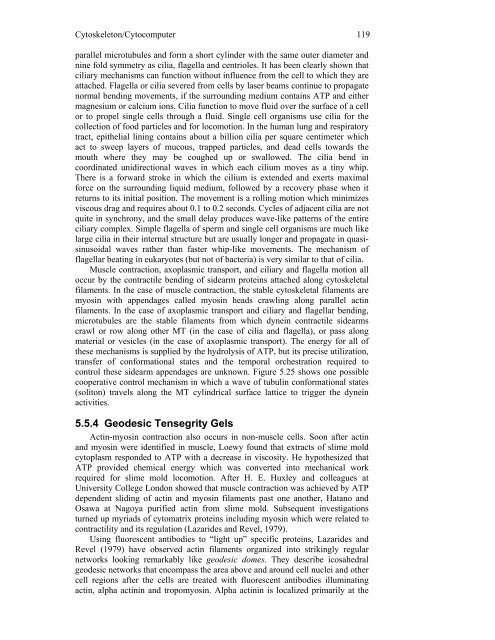ULTIMATE COMPUTING - Quantum Consciousness Studies
ULTIMATE COMPUTING - Quantum Consciousness Studies
ULTIMATE COMPUTING - Quantum Consciousness Studies
- No tags were found...
You also want an ePaper? Increase the reach of your titles
YUMPU automatically turns print PDFs into web optimized ePapers that Google loves.
Cytoskeleton/Cytocomputer 119<br />
parallel microtubules and form a short cylinder with the same outer diameter and<br />
nine fold symmetry as cilia, flagella and centrioles. It has been clearly shown that<br />
ciliary mechanisms can function without influence from the cell to which they are<br />
attached. Flagella or cilia severed from cells by laser beams continue to propagate<br />
normal bending movements, if the surrounding medium contains ATP and either<br />
magnesium or calcium ions. Cilia function to move fluid over the surface of a cell<br />
or to propel single cells through a fluid. Single cell organisms use cilia for the<br />
collection of food particles and for locomotion. In the human lung and respiratory<br />
tract, epithelial lining contains about a billion cilia per square centimeter which<br />
act to sweep layers of mucous, trapped particles, and dead cells towards the<br />
mouth where they may be coughed up or swallowed. The cilia bend in<br />
coordinated unidirectional waves in which each cilium moves as a tiny whip.<br />
There is a forward stroke in which the cilium is extended and exerts maximal<br />
force on the surrounding liquid medium, followed by a recovery phase when it<br />
returns to its initial position. The movement is a rolling motion which minimizes<br />
viscous drag and requires about 0.1 to 0.2 seconds. Cycles of adjacent cilia are not<br />
quite in synchrony, and the small delay produces wave-like patterns of the entire<br />
ciliary complex. Simple flagella of sperm and single cell organisms are much like<br />
large cilia in their internal structure but are usually longer and propagate in quasisinusoidal<br />
waves rather than faster whip-like movements. The mechanism of<br />
flagellar beating in eukaryotes (but not of bacteria) is very similar to that of cilia.<br />
Muscle contraction, axoplasmic transport, and ciliary and flagella motion all<br />
occur by the contractile bending of sidearm proteins attached along cytoskeletal<br />
filaments. In the case of muscle contraction, the stable cytoskeletal filaments are<br />
myosin with appendages called myosin heads crawling along parallel actin<br />
filaments. In the case of axoplasmic transport and ciliary and flagellar bending,<br />
microtubules are the stable filaments from which dynein contractile sidearms<br />
crawl or row along other MT (in the case of cilia and flagella), or pass along<br />
material or vesicles (in the case of axoplasmic transport). The energy for all of<br />
these mechanisms is supplied by the hydrolysis of ATP, but its precise utilization,<br />
transfer of conformational states and the temporal orchestration required to<br />
control these sidearm appendages are unknown. Figure 5.25 shows one possible<br />
cooperative control mechanism in which a wave of tubulin conformational states<br />
(soliton) travels along the MT cylindrical surface lattice to trigger the dynein<br />
activities.<br />
5.5.4 Geodesic Tensegrity Gels<br />
Actin-myosin contraction also occurs in non-muscle cells. Soon after actin<br />
and myosin were identified in muscle, Loewy found that extracts of slime mold<br />
cytoplasm responded to ATP with a decrease in viscosity. He hypothesized that<br />
ATP provided chemical energy which was converted into mechanical work<br />
required for slime mold locomotion. After H. E. Huxley and colleagues at<br />
University College London showed that muscle contraction was achieved by ATP<br />
dependent sliding of actin and myosin filaments past one another, Hatano and<br />
Osawa at Nagoya purified actin from slime mold. Subsequent investigations<br />
turned up myriads of cytomatrix proteins including myosin which were related to<br />
contractility and its regulation (Lazarides and Revel, 1979).<br />
Using fluorescent antibodies to “light up” specific proteins, Lazarides and<br />
Revel (1979) have observed actin filaments organized into strikingly regular<br />
networks looking remarkably like geodesic domes. They describe icosahedral<br />
geodesic networks that encompass the area above and around cell nuclei and other<br />
cell regions after the cells are treated with fluorescent antibodies illuminating<br />
actin, alpha actinin and tropomyosin. Alpha actinin is localized primarily at the






